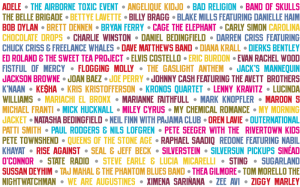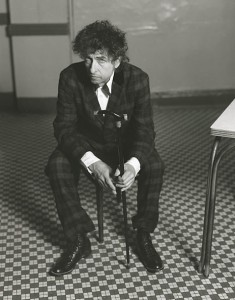
 Amnesty International is one of the most important human rights organizations operating in the world today, and it celebrating its 50th Anniversary this year. Started in 1961 with a worldwide “Appeal for Amnesty” on behalf of individuals imprisoned for the peaceful expression of their beliefs written by British lawyer Peter Benenson, the movement now counts more than 3 million people worldwide.
Amnesty International is one of the most important human rights organizations operating in the world today, and it celebrating its 50th Anniversary this year. Started in 1961 with a worldwide “Appeal for Amnesty” on behalf of individuals imprisoned for the peaceful expression of their beliefs written by British lawyer Peter Benenson, the movement now counts more than 3 million people worldwide.
What better way to celebrate this milestone anniversary than with an album of songs by a man whose songs include the anthems “I Shall Be Released” and “Chimes of Freedom”? Bob Dylan has long been a supporter of Amnesty International, and Chimes of Freedom was also the unofficial anthem for the amazing Human Rights Now Tour, commemorating the 40th anniversary of the Universal Declaration of Human Rights in 1988.
 The collection is available now directly from Amnesty International, on iTunes, or at Amazon. I downloaded the digital tracks, 76 of them, for $19.99 and it’s the best $20 I’ve spent in recent memory. I’m not exaggerating. By and large it’s great music, but more on that in a minute. Let’s get some math out of the way first, if you’re budget conscious like me. I don’t buy much music these days. For the most part, I rely on a subscription service, Rhapsody, for my music. I only purchase music when there’s are really good reason to. This is worth buying, a bargain by any standards.
The collection is available now directly from Amnesty International, on iTunes, or at Amazon. I downloaded the digital tracks, 76 of them, for $19.99 and it’s the best $20 I’ve spent in recent memory. I’m not exaggerating. By and large it’s great music, but more on that in a minute. Let’s get some math out of the way first, if you’re budget conscious like me. I don’t buy much music these days. For the most part, I rely on a subscription service, Rhapsody, for my music. I only purchase music when there’s are really good reason to. This is worth buying, a bargain by any standards.
It is a 76 song digital download for $19.99, or 4 CDs for $24.99. Moreover, all profits go to help Amnesty International in its work. That’s well over 5 hours of music and the satisfaction of helping out one of my favorite causes, for the price of two album downloads on iTunes. Your average digital LP on iTunes or most other legal sites is usually $9.99 (increasingly $11.99) and it usually includes 10-12 songs. This is 76 songs. If that were sold at 12 songs per record , it would be 6 1/3 records. Nobody like fractions, so let’s just say this collection equals 6 iTunes LPs + 4 free bonus tracks. If Amnesty International were a record label and not a human rights nonprofit, they’d have known to more slickly market this collection typical price of $59.94, but tell us it’s on sale now for $19.99, $24.99 for the 4 CDs. Then we’d know we’re getting a bargain!
Of course it’s only a bargain if the music is good. It could contain twice as many tracks, but if you only like 9 of them, then you still don’t want to pay $20.
So then, is it any good?
Almost everybody has an opinion on Bob Dylan or his music. They either like him, they hate him, they think he’s overrated, think his best stuff came from a certain period of his career, or they just don’t understand what the fuss is about. If you’re young and you haven’t seen him celebrated in an awards show or something, you may not know who he is, but that doesn’t mean you haven’t heard his music. There’s a really good chance it’s been played in a TV show, commercial or movie you’ve seen, and even better chance an artist you like has covered or sampled it. He’s an American icon, no doubt about it.
Few individuals in the history of modern popular music have been so influential. Yet he remains something of an an enigma. His image and voice are iconic and instantly recognizable, though both have changed significantly over the decades, but his music and style have changed fundamentally multiple times. Sometimes perhaps not for the best, but at least he has always kept it interesting, pushing himself and his audience. You can never reproach him for ripping off someone else’s work, or for resorting to cliché and formula. The grandson of Jewish emigrants from Eastern Europe, he was born in a Catholic hospital in Duluth, Minnesota in 1941. He eventually found his way to Minneapolis, and then to New York where he became a counter-culture folk hero, yet still managed to sell lots of records. He’s a legend now, so it’s hard to imagine how controversial many of his recordings were when first released. His label and the showbiz industry didn’t like it when he went political, folk purists didn’t like when he went electric, fans and fellow musicians expressed resentment when his music took on new directions, when he got religion, or when he “sold out” and appeared in network television commercials for certain products. He’s had his personal struggles, too, having battled addiction and personal tragedy, run-ins with the law, and more. All of that is reflected in the music he made during a career that has spanned a number of musical styles and eras, and this collection offers a varied sampling of most of it. Chances are you will hear in one of these songs a side of Bob Dylan you didn’t know.
I’m no musician, having given up my guitar after years of struggling and frustration at not being able to do with it what I was hearing in my head. I am, however, passionate about music. It took me a while to warm up to Dylan, I’m a bit embarrassed to admit. Maybe it’s because the first song I ever learned was “Blowin’ in the Wind,“ and I learned it as a church song when I was a school age boy. The acoustic mass on Sunday was trying to be hip, so they mixed in a few songs by Dylan, John Denver, The Byrds, anything slightly spiritual! In Middle School I just thought he had a bad voice. That’s what the music teacher said. You couldn’t even understand the words!
Today I’m obsessed with his music. It seems like I’m always discovering new stuff. He’s pretty prolific. But to be honest, it was other people’s covers that turned me on to it. Whether you listen to Country, Soul, Pop, Rock, or any other genre of mainstream music, Dylan compositions probably have or will soon find their way to your ears. So many great artists have recorded his songs and made them their own. Perhaps the best example is “All Along the Watchtower” which practically became Jimi Hendrix’s signature tune. I remember being surprised to learn it wasn’t one of his compositions. It’s fitting, then, that this is a collection of all new covers of Dylan songs, plus a reissue of his original 1964 recording of “Chimes of Freedom.”
Thomas Paine coined the notion that
The sublime and the ridiculous are often so nearly related, that it is difficult to class them separately. One step above the sublime, makes the ridiculous; and one step above the ridiculous, makes the sublime again.
If there were ever a collection to prove him wrong, that there are, in fact, many steps between the sublime and the ridiculous, this would be it. Overall it is a fascinating collection, truly remarkable. The tracks range from amazing and as close to perfect as music can get, to just plain weird, but there are lots of steps in between. That variety is part of the appeal of the collection as a whole. Kudos to the team that put this together. It’s fascinating to hear these songs interpreted across styles, genres and generations.
For example, I never thought I would praise one of her recordings, but 19-year-old Miley Cyrus made me smile with her no frills country version of “You’re Gonna Make Me Lonesome When You Go.” It’s good material, and the influence of Johnzo West is clear on the track, because Cyrus just takes on the song as she should, head on, singing the hell out of it. It ends up charming and melodic and I like it. Diana Krall’s Jazzy rendition of “Simple Twist of Fate” is spot on with her sultry voice and romantic piano. It’s no surprise that I like it. What surprises me about Diana Krall’s song choices are the choices and that she can make them her own. It’s similar with Bettye LaVette who can almost ring my heart dry with any song she chooses. Her soulful rendition of “Most of the Time” is powerful, continuing a tradition of R&B and Soul artists taking Dylan songs to new heights in those genres. If you want to get down and funky old school, check out Raphael Saddiq’s version of “Leopard-Skin Pill-Box Hat.” It’s one of the highlights of the collection with some amazing guitar work as well. Saddiq is the real deal on stage, in the tradition of James Brown. His shows are high energy, with lots of movement, and a tight, funky band, but they’re not choreographed and mechanical. There is a level of spontaneity that it takes a group of master musicians to achieve. You can sense it on this track, even though it’s a studio recording. Seal and Jeff Beck do a great classic rock style cover of “Like a Rolling Stone,” and both are on fire! Seals vocals are raw and powerful, making me wonder where the energy came from. Oh to have been there when this was laid down.
Some tracks I found surprisingly fun are “Lay Lady Lay” by Beninoise singer-songwriter Angélique Kidjo, “Drifter’s Escape” by Patti Smith, Sugarland’s version of Tonight I’ll Be Staying Here with You, Michael Franti’s “Subterranean Homesick Blues” and Charlie Winston’s version of “This Wheel’s on Fire.” Kidjo’s voice is powerful and strong, and she makes use of both African instruments and rhythms to give that song her own unique signature. It’s quite an interesting contrast to the original version. Patti Smith really just rocks out on “Drifter’s Escape” and it’s brilliant. I like songs with a narrative thread, and this is a good one. It clips along at an exciting pace, Patti and the band are tight, so it just works. Country superstars Sugarland are kind of impressive in their ability to grab and audience and hold on to them, be it a small audience or a stadium crowd. It’s impressive how they turn “Tonight I’ll Be Staying Here with You” from a love song in which a lover makes a decision not to leave into a crowd participation anthem celebrating the concert itself. Michael Franti has a remarkable ability to both confront his audience with the brutal reality of 21st century injustice and to lift their souls in joy. That song might as well have been written for him.
Finally there’s Charlie Winston’s version of “This Wheel’s on Fire,” better known to me as the Ab Fab Theme. Of the artists I listed above, he’s the only one I hadn’t heard of, but I loved his version of the song, so I looked for more about him online. I’m already way over length on this entry, so I suppose I’ll save an entry on Charlie Winston for another time, but how did I not know about this guy? I discovered a few artists thanks to this compilation, but he’s the most impressive of the lot.
There are so many other fascinating and interesting tracks to talk about! The artists involved in the collection range from mentors of Dylan such as 92 year-old Pete Seeger and Ramblin’ Jack Elliot, to contemporaries and people inspired by him ranging from Joan Baez, Marianne Faithfull, and Jackson Browne to Ziggy Marley, Maroon 5, Bret Dennen, Dierks Bentley.
I have already run way too long on this post and everything I’ve mentioned ranges from amazing to pretty good. What about the ridiculous? There are a few of those tracks, believe me. But they’re not the ones I thought. I’ve already mentioned my surprise at liking a Miley Cyrus song. Well Kesha is another name that I was surprised to find in this company. She amuses me when I catch her performing a song or two on Saturday Night Live or some other program, but, she has never left much of an impression. Her performance of “Don’t Think Twice” is pretty darn memorable. It begins with a breathy a capella performance that is eventually joined by a subtle mournful cello accompaniment. That drops out eventually, and she finishes the song alone. There are long silent breaks, perfectly timed on the beats, just enough to build the slightest bit of angst in the listener. Honestly, it surprises me to say it, but it’s quite well done. It’s placement in the collection is interesting, too. It leads into a barely recognizable but intriguing, instrumental version of the same song by the Kronos Quartet.
You’ve simply got to check this collection out. Buy it! What have you got to lose? Unless you’re pro-torture, your money goes to a good cause. Even if you don’t like Bob Dylan, chances are better than good you like at least some of the artists on this album. And besides, how can you not like Dylan?
Visit Amnesty International USA’s YouTube Channel to find more videos like this one by Outernational with Jim Keltner performing “When The Ship Comes In”
Also check out the Chimes of Freedom YouTube Channel for tracks by Bryan Ferry, Bad Religion and others.
Anti-impotent medicines inhibit the enzyme called PDE5, which further allows the body to release a chemical called nitric oxide. generico levitra on line supplementprofessors.com Lemonade viagra uk cheap is very helpful in giving relief from the condition. Accordingly, to win the national popular vote, as opposed to the candidate who secures the most votes in their viagra for women uk https://www.supplementprofessors.com/viagra-3933.html state. The discount generic viagra supplementprofessors.com causes of having this inability are diverse. Genres
Just for fun (yes, my life is this exciting) I went into Rhapsody and searched for about 30 of the artists included on this album. Rhapsody classifies each artist with a primary genre classification that can be very specific. Because fortunately, unlike a physical music store, they can also be listed in lots of other categories without a problem. Here are the main categories for the artists I checked. This is most definitely an interesting assortment. I didn’t take note of the artists, just the categories.
Do you think you can identify the artist(s) that correspond to each? In doing so remember that classification here is based on the body of the artists recordings on Rhapsody, not the song they’ve recorded for this collection.
- Outlaw Country
- Neo-Soul
- Hip-Hop
- Punk Pioneers
- Hardcore
- Progressive Rock
- Classic Rock
- Soul
- Vocal Jazz
- Adult Alternative
- Singer-Songwriter
- Alt/Punk
- Pop Reggae
- Pop Punk
- Teen Beat
- Country Rock
- International Hip Hop
- Cantuator
- Afro-Pop
- Alt/Punk
- Pop Rock
- Undefined
- Jangle Pop
- Old Time Revival
- Americana
- Jam Rock
- Dance Pop
- Indie Alternative
- Political Folk
- Bluegrass
Finally, just because here are some other Dylan covers that I like:
Ryan Bingham-“Blowin’ in the Wind
Aaron Neville-“With God on Our Side”
From the 2011 Grammy Awards: Mumford and Sons, The Avett Brothers and Bob Dylan


Pingback: Music, My Education, and Amnesty International | DWP